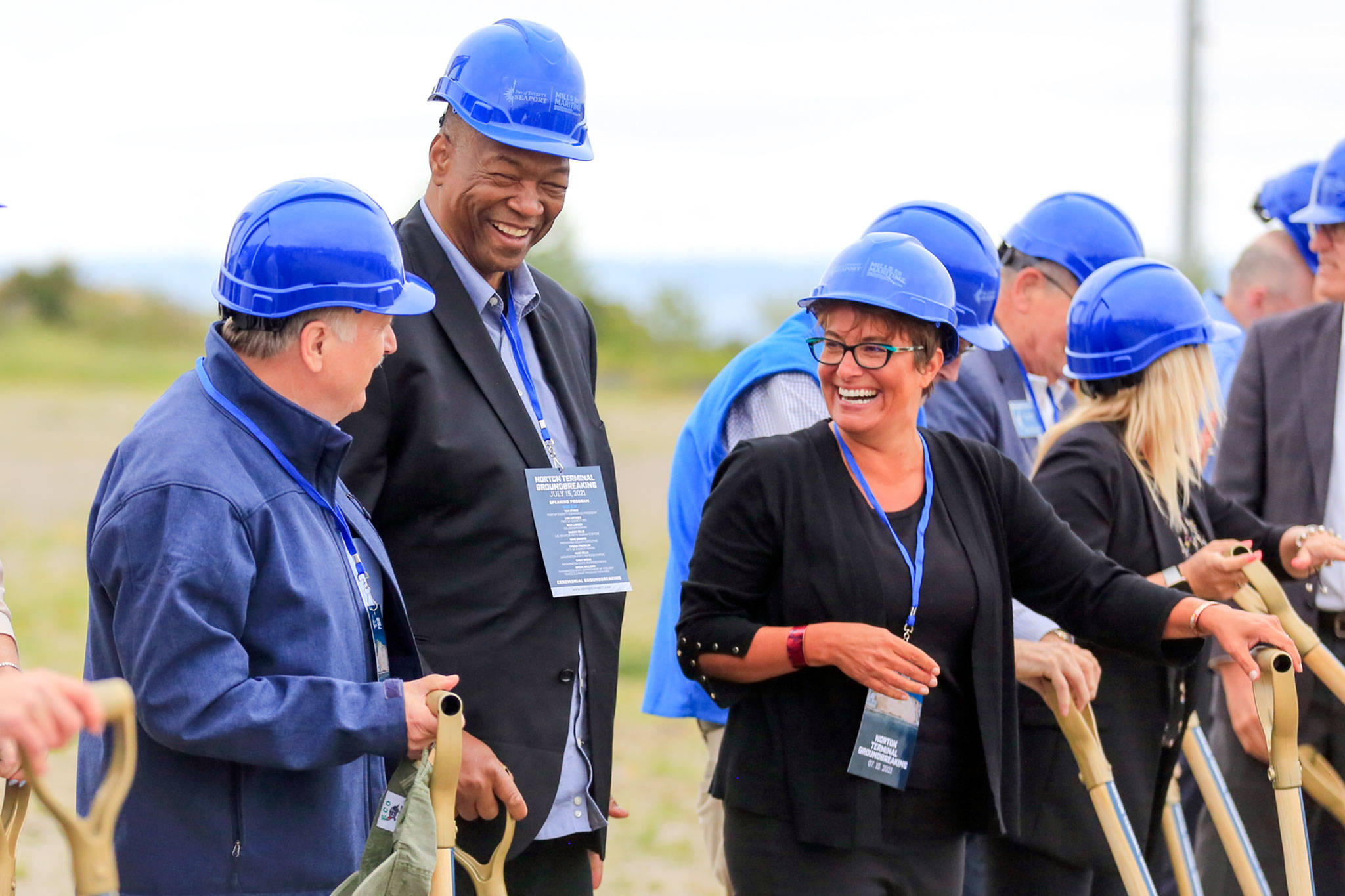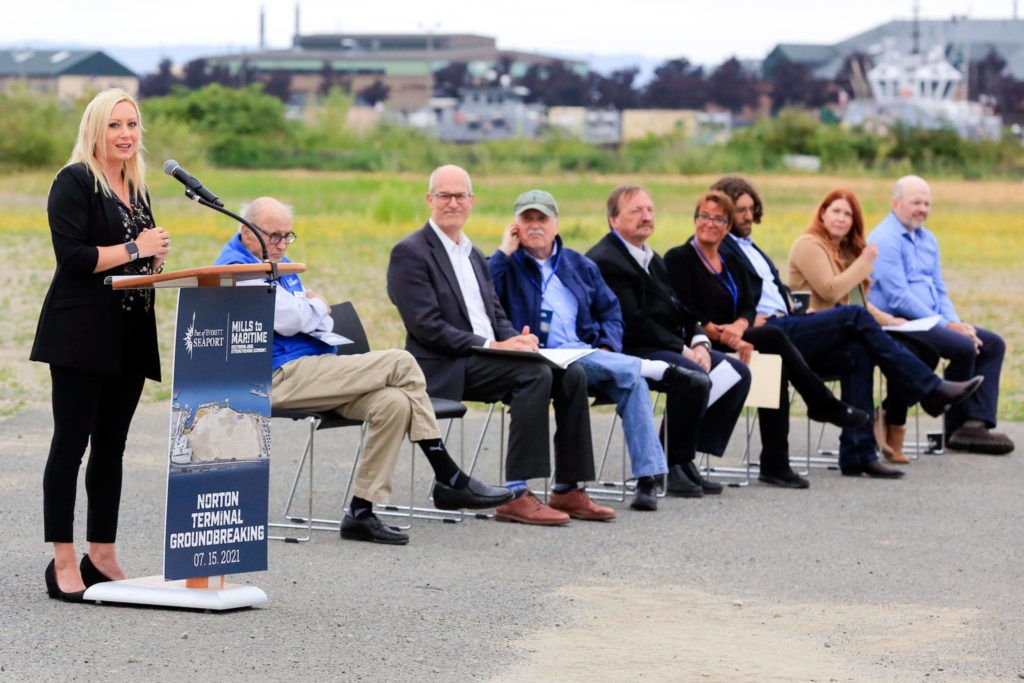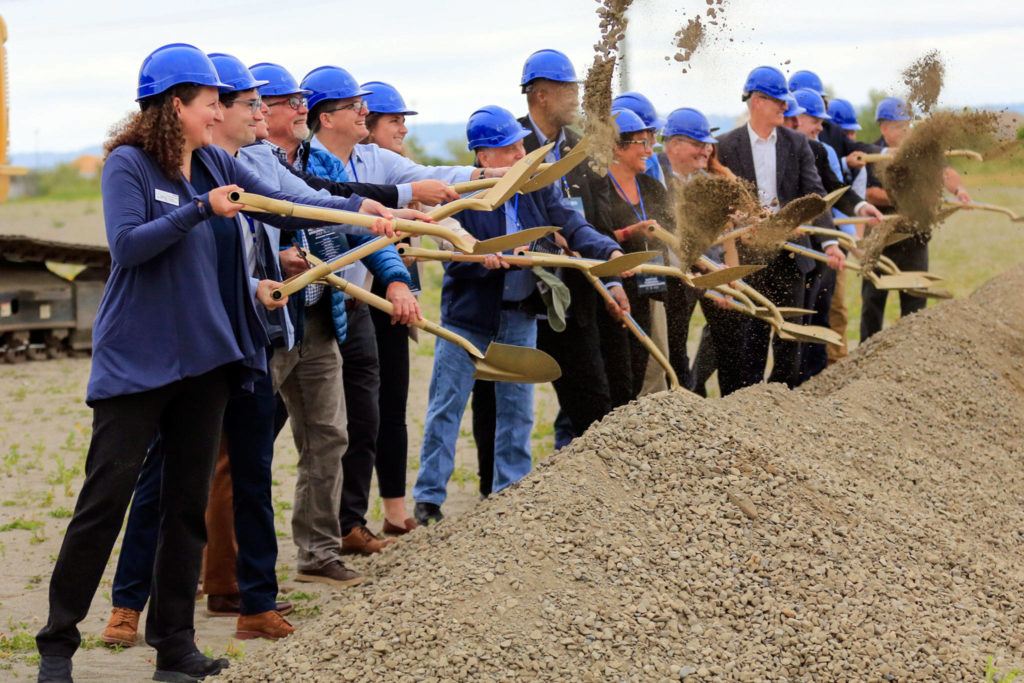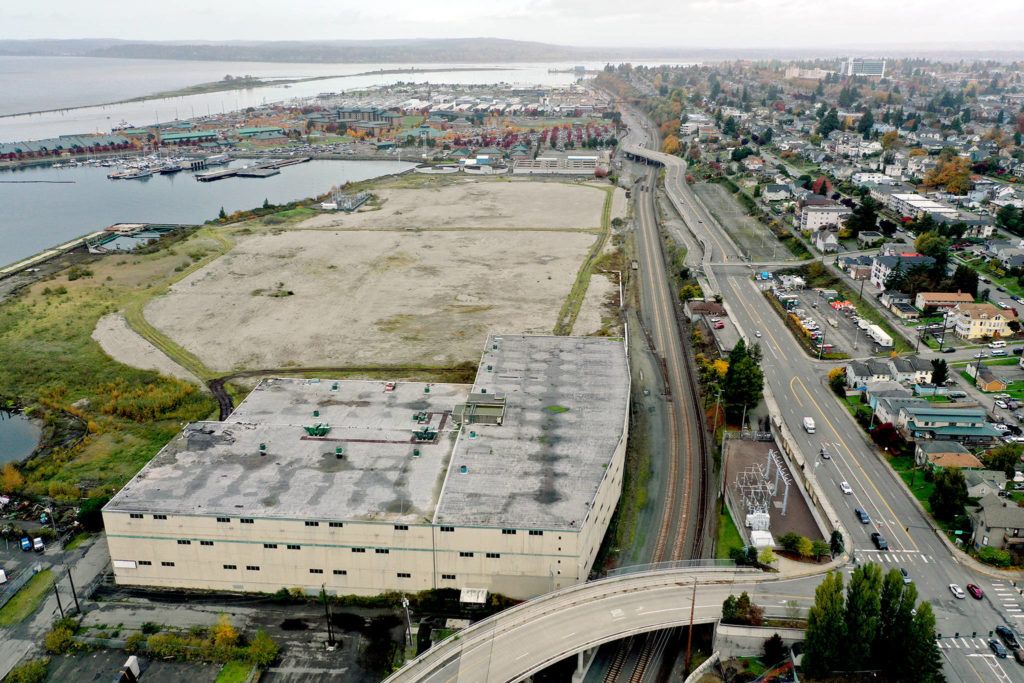EVERETT — Though dump trucks hauled away some 14,000 loads of polluted material last year, much remains below the surface where the Kimberly-Clark pulp and paper mill once stood along the waterfront.
Metals, PCBs and other chemical remnants of milling still taint sand and silt, highly vulnerable to seismic shifts.
Pilings that once supported mill buildings are buried alongside debris of brick and concrete.
Sawdust and other wood wastes fill underground pockets up to 40 feet deep that will compress under heavy weight.
The vestiges of the plant’s century-long life make for conditions geotechnical consultants have deemed “challenging.”
The Port of Everett is confronting those problems in an effort to restore the property’s status as a local economic powerhouse by building a new marine shipping terminal there.
“The devil in this project really is underground,” said Port CEO Lisa Lefeber at a Thursday groundbreaking ceremony for the long-awaited Norton Terminal.
Snohomish County Executive Dave Somers, Everett Mayor Cassie Franklin and U.S. Rep. Rick Larsen of Everett were among local leaders who dug into a gravel pile to kick off the construction, which port officials say will bring jobs back to the site and address remaining pollution on the land.
The 58-acre waterfront property, between the International Seaport and Naval Station Everett, has been vacant and lifeless since the mill shuttered in 2012.
“What we do is put contaminated brownfield sites back into productive use,” Lefeber said, thanking her staff. “It looks easy. It is not easy. To marry environmental cleanup, economic development and job creation, all in one project, seamlessly — it takes great skill.”
Crews will first need to first spread about 50,000 cubic yards of crushed rock over 5 acres of the site to “pre-load” the land — to compress the soft wood materials beneath the surface — preventing those spots from sinking further once the terminal is developed.
The material will be piled about 6 feet high, then removed and reused as a gravel base for an asphalt “cap” that will cover about 32 acres of the site. The pavement will keep residual contamination from seeping into the water, port officials say.
The project will include stormwater treatment facilities, too, to improve the quality of runoff into Puget Sound.
Construction began Tuesday. The terminal is set to open in 2022, roughly 10 years after Kimberly-Clark shuttered the plant.
‘It was going to be complex’
The terminal is expected to cost $36 million. Most of that cost will be covered by a $17.75 million grant from the U.S. Department of Transportation Maritime Administration and a $7.65 million grant from the state Department of Ecology’s Toxics Cleanup Program.
Costs associated with finishing the environmental cleanup are expected to account for about $28 million of the $36 million total, according to port financial records.
Port officials have known for years about the underground debris, seismic hazards and other problems with the site, Lefeber said.
The mill complex operated for nearly 100 years under varying ownership. Its closure left about 700 people without jobs.
In the years that followed, tentative deals that would have put the land in private hands unraveled amid questions over the remaining cleanup — including who would pay for it.
The port took a “calculated risk” when it purchased the site from Kimberly-Clark in late 2019, under the threat of condemnation, to expedite the cleanup and bring the property back into use, Lefeber said.
“We knew it was going to be expensive. We knew it was going to be complex,” she said in an interview this week. “But we also knew that we were the only ones that were going to be able to get that site into use any time soon.”
In exchange for assuming all of Kimberly-Clark’s environmental liabilities, the port got a discount: It paid $33 million and got a $17 million credit to eventually address pollution on the part of the site that’s submerged under water.
Roughly 12 acres of tidelands are part of what is known as the East Waterway, another environmental cleanup site. The port, the U.S. Navy and the state are in the early stages of gathering information about pollution that lingers there after decades of industrial and maritime activity.
Under the terms of the sale, Kimberly-Clark agreed to make major progress on the upland cleanup by decommissioning shoreline pipes, removing roughly 12,000 tons of contaminated soil and hauling away some 200,000 tons of crushed material left from the mill’s demolition. The company completed those efforts by the end of last year, as promised.
When the port acquired the site, it agreed to “indemnify” the company from future environmental claims, such as lawsuits or enforcement actions, related to the presence of hazardous substances “in, under or migrating from” the property, according to the purchase and sale agreement.
The company made no other guarantees about “the physical condition or any other aspect of the property” — including soil stability and susceptibility to landslides, as well as any presence of “asbestos, underground or above ground storage tanks, hazardous waste or other toxic or hazardous materials of any kind.”
The port agreed to lead the completion of the upland cleanup when it signed an agreement with Ecology in May.
In addition to constructing the environmental cap, the port committed to finishing a “remedial investigation/feasibility study” and “cleanup action plan” for the site.
The documents are both key steps under the Model Toxics Control Act, which dictates how environmental cleanups must be conducted in Washington.
The drafted cleanup action plan will be released to the public for comment, said Cheryl Ann Bishop, a spokeswoman for the Ecology Department.
The final version of the plan “will contain the cleanup requirements and will include an environmental covenant for the site to remain industrial along with institutional controls and long-term monitoring requirements,” Bishop said in an email.
Port officials say those reports are “administrative steps.”
‘You can’t see the work’
The last physical cleanup action for the site will be complete when the site is capped during construction, Lefeber said.
Testing has shown there’s some “residual” contamination at the site, but not enough for the Ecology Department to require removal, said Erik Gerking, the port’s director of environmental programs.
According to project documents, the following contaminants still exist in soil and groundwater on the site at concentrations above cleanup levels: arsenic, copper, lead, mercury, nickel, zinc, carcinogenic polycyclic aromatic hydrocarbons (cPAHs), polychlorinated biphenyls (PCBs) and petroleum hydrocarbons.
Since the early 2000s, the port has invested more than $33 million to rid the waterfront of historic contamination, according to its Environmental Stewardship and Sustainability Report 2020.
An example of that success is the Riverside Business Park, a former Weyerhaeuser mill site that now supports hundreds of jobs.
Costs associated with such cleanups are some of the few expenses that the port can pay with taxpayer dollars, which account for about 8% of its $61 million 2021 budget.
Questions about land stability and underground obstructions are common issues encountered during environmental remediation, according to port officials.
“Cleanup projects are extremely challenging,” Gerking said. “It’s the nature of the work that makes things so uncertain. Because you can’t see the work — you can’t see the contamination when you look … It’s a discovery process.”
Engineers examined the former Kimberly-Clark mill site in 2020 and 2021, adding some new detail to the port’s body of knowledge about the site and confirming much of what was already known.
None of the findings were surprises, Lefeber said.
“Our team knew exactly what we were getting into,” she said.
A June geotechnical engineering report, prepared by Landau Associates, provides advice to the port for dealing with the “challenging subsurface conditions,” including the foundation remnants and other debris underground.
One recommendation is pre-loading the land, as crews are doing now as part of a $2.7 million contract.
Another suggestion is to add layers of synthetic “geogrid” material beneath the pavement to ensure the cap keeps its shape in areas where foundation remnants are buried near the surface. The project team incorporated that recommendation, too.
The city of Everett previously sued Kimberly-Clark, alleging that the company failed to meet permitting requirements when it demolished buildings at the site in 2012 and 2013 and left most of the rubble exposed, instead of covering it with topsoil and grass to contain the pollution.
That lawsuit was dismissed this year after the state Department of Ecology deemed the company’s last cleanup effort complete.
Data have suggested the soils there are “highly susceptible” to earthquake liquefaction, which occurs when water-saturated soil loses its strength and stiffness and behaves like a liquid, the recent geotechnical engineering report says. Liquefaction is a common cause for concern in many areas of Snohomish County and across the seismically active Pacific Northwest.
At the Kimberly-Clark site, “shoreline features could experience significant, inelastic deformation,” the geotechnical report says. “Additionally, horizontal and vertical ground displacement could occur behind existing structures located within 100 to 200 ft of the shoreline.”
Those concerns were taken into account when the project was designed, said port spokeswoman Cat Soper. Because the project is a paved cargo yard — and not a major structure — there’s less risk, Soper said in an email.
Any future additions may need to be designed to “resist seismic hazards,” the report says. Solutions could include installing stone columns deep underground, or mixing or compacting soils to improve their stability.
The port is evaluating its options for a 360,000-square-foot warehouse on the site that’s already supported by piles, Soper said. Officials have discussed leasing the facility. But the building would need significant rehabilitation, including roof repairs and HVAC and electrical work, an assessment found.
‘Return on investment’
The port commission on Tuesday approved an $800,000 increase in its contract with KPFF Consulting Engineers, the Seattle-based firm that designed the terminal, bringing that contract total to $3.4 million.
The firm will be responsible for monitoring the site following the pre-load work to ensure that the underground wood waste is consolidating as expected, said port staff engineer John Klekotka. KPFF will also oversee the progress of the terminal construction and manage any potentially contaminated soils unearthed in the process.
Soils showing signs of contamination will be separated and tested, Klekotka said. The port will report to back to Ecology with test results to determine whether the soils need to be removed and disposed of at a designated off-site facility.
“That’s going to be a major effort on this project,” he told the commission.
The port expects to award the primary construction contract for the Norton Terminal in August.
The new terminal will support more than 950 jobs. Its construction is expected to employ another 800 people temporarily.
The addition will be “a great return on investment” for the port, providing family-wage jobs and more capacity for cargo, said Port Commissioner Tom Stiger.
“We’ve had to turn down shipments just because of the fact that we couldn’t accommodate the customer,” Stiger said. “So this is going to really pay back in terms of providing the additional revenue and the additional work for the longshoreman and the people involved in handling our cargo operation.”
He said the port’s understanding of lingering pollution at the site is “about as clear as you can expect it to be at this point,” considering how much it’s invested in studying the contamination there.
“I feel pretty comfortable,” said Stiger, who worked at the mill site in the 1960s, when it was owned by Scott Paper Co.
Then, he was a college student. Now he’s 83.
“But, you know,” he said, “you can never be surprised what you might find after 90 years of mill operations at that site.”
Rachel Riley: 425-339-3465; rriley@heraldnet.com. Twitter: @rachel_m_riley.
Talk to us
> Give us your news tips.
> Send us a letter to the editor.
> More Herald contact information.





























